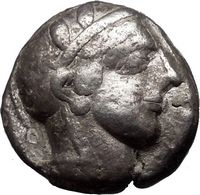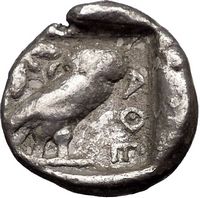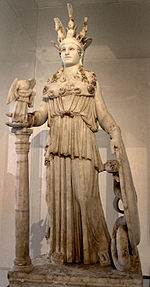Athens Authentic Ancient Coins for sale and History
Below
you will find a selection of Athens Authentic Ancient Coins for sale
You
can also explore my selection of affordable ancient Roman coins or
affordable ancient Medieval Byzantine coins
Buy certified authentic ancient Greek coins of Athens, the birthplace
of Democracy today. Read a history about Athens and explore a selection
of ancient coins of Athens available for sale on eBay.
Learn about history by owning it. All coins you purchase from his
store are professionally researched, photographed and provided with a
lifetime guarantee of authenticity. They also come complete with a
custom-made signed, full-color, professionally researched CERTIFICATE of
AUTHENTICITY, a $50-$100 value, absolutely Free. Visit his website and
explore a selection of thousands of certified authentic ancient Greek,
Roman, Biblical, Byzantine coins, artifacts and beyond. A fun way to
learn about and preserve history for future generations. Ancient coins
make a great gift, investment and collection all in one. Find out for
yourself what over 10,000 other satisfied customers say about their
experience and start your ancient coin collection today.


Example of Authentic Ancient
Coin of:
Greek city of Athens in Attica Greece -
Silver Tetradrachm 24mm (16.85 grams) Struck circa 393-300 B.C.
Reference: Sear 2537; B.M.C. 11. 144
Head of Athena right, of more advanced style, the eye seen in true
profile; she wears crested helmet ornamented with three olive-leaves and
floral scroll.
Owl standing right, head facing; to right AΘE;
to left, olive-twig and crescent.
Athens (//; Modern
Greek: Αθήνα, Athína; IPA: [aˈθina]; Katharevousa:
 Ἀθῆναι, Athinai; Ancient
Greek: Ἀθῆναι, Athēnai)
is the capital and
largest city of Greece.
Athens dominates the Attica region
and is one of the world's
oldest cities, with its recorded
history spanning
around 3,400 years. Classical
Athens, as a landlocked location was a powerful city-state that
emerged in conjunction with the seagoing development of the port of Piraeus.
A centre for the arts, learning and philosophy,
home of Plato's Academy and Aristotle's Lyceum, it
is widely referred to as the cradle of
Western civilization and the birthplace of democracy, largely
due to the impact of its cultural and political achievements during the
5th and 4th centuries BC in later centuries on the rest of the then
known European
continent. Today a
cosmopolitan metropolis, modern Athens is central to economic,
financial, industrial, political and cultural life in Greece. In 2008,
Athens was ranked the world's 32nd
richest city by
purchasing power and the 25th
most expensive in a UBS study. Ἀθῆναι, Athinai; Ancient
Greek: Ἀθῆναι, Athēnai)
is the capital and
largest city of Greece.
Athens dominates the Attica region
and is one of the world's
oldest cities, with its recorded
history spanning
around 3,400 years. Classical
Athens, as a landlocked location was a powerful city-state that
emerged in conjunction with the seagoing development of the port of Piraeus.
A centre for the arts, learning and philosophy,
home of Plato's Academy and Aristotle's Lyceum, it
is widely referred to as the cradle of
Western civilization and the birthplace of democracy, largely
due to the impact of its cultural and political achievements during the
5th and 4th centuries BC in later centuries on the rest of the then
known European
continent. Today a
cosmopolitan metropolis, modern Athens is central to economic,
financial, industrial, political and cultural life in Greece. In 2008,
Athens was ranked the world's 32nd
richest city by
purchasing power and the 25th
most expensive in a UBS study.
The city of Athens has a population of 664,046 (796,442
in 2004) within its
administrative limits and a land area of 39 km2 (15 sq mi). The urban
area of Athens (Greater
Athens and Greater
Piraeus) extends beyond the administrative municipal city
limits, with a population of 3,074,160 (in 2011), over
an area of 412 km2 (159 sq mi). According
to Eurostat,
the Athens Larger
Urban Zone (LUZ)
is the 7th most populous LUZ in the European
Union (the 4th
most populous capital city of the EU),
with a population of 4,013,368 (in 2004). Athens is also the
southernmost capital on the European mainland.
The heritage of the classical
era is still
evident in the city, represented by ancient
monuments and
works of art, the most famous of all being the Parthenon,
considered a key landmark of early Western
civilization. The city also retainsRoman and Byzantine monuments,
as well as a smaller number of Ottoman monuments.
Athens is home to two UNESCO
World Heritage Sites, the Acropolis
of Athens and the
medieval Daphni
Monastery. Landmarks of the modern era, dating back to the
establishment of Athens as the capital of the independent Greek state in
1834, include the Hellenic
Parliament (19th
century) and the Athens Trilogy, consisting of the National
Library of Greece, the Athens
University and the Academy
of Athens. Athens was the host city of the first
modern-day Olympic Games in
1896, and 108 years later it welcomed home the 2004
Summer Olympics. Athens
is home to the National
Archeological Museum, featuring the world's largest
collection of ancient Greek antiquities, as well as the newAcropolis
Museum.
Etymology

Athena, patron goddess of
Athens
In Ancient
Greek Athens' name
was Ἀθῆναι (Athēnai, [atʰɛ̂ːnai])
in plural. However, in earlier Greek, such as Homeric
Greek, the name was in the singular form, as Ἀθήνη (Athēnē) and
was then rendered in the plural, like those of Θῆβαι (Thēbai)
and Μυκῆναι (Μukēnai).
The root of the word is probably not of Greek or Indo-European origin,
and is a possible remnant of the Pre-Greek
substrate of
Attica, as with the name of the goddess Athena (Attic Ἀθηνᾶ Athēnā, Ionic Ἀθήνη Athēnē and Doric Ἀθάνα Athānā),
who was always related to the city of Athens. During the medieval period
the name of the city was rendered once again in the singular as Ἀθήνα [aˈθina].
However, because of the conservatism of the written language, Ἀθῆναι [aˈθine] remained
the official name of the city until the abandonment ofKatharevousa in
the 1970s, when Ἀθήνα became the official name.
Previously, there had been other etymologies by scholars of the 19th
century. Lobeck proposed
as the root of the name the word ἄθος (athos)
or ἄνθος (anthos)
meaning flower, to denote Athens as theflowering city.
On the other hand, Döderlein proposed
the stem of the verb θάω,
stem θη– (thaō,
stem thē–, "to suck")
to denote Athens as having fertile soil.
An etiological
myth explaining
how Athens acquired this name was well known among ancient Athenians and
even became the theme of the sculpture on the West pediment of the Parthenon.
Both Athenaand Poseidon requested
that they become patrons of the city and give their name to it,
competing with one another for the honour, and offering the city one
gift each. Poseidon produced a salt water spring by
striking the ground with his trident, symbolizing naval
power. However, some myths suggest that he created horses out
of sea foam as a gift for Athens. Athena created the olive
tree, symbolizing peace andprosperity.
The Athenians, under their ruler Cecrops,
accepted the olive tree and named the city after Athena.
The city is often referred to with its nickname in Greek as τὸ
κλεινὸν ἄστυ, which means in English the
glorious city or simply
as η
πρωτεύουσα (protevousa),
'the capital'.
History
The oldest known human presence in Athens is the Cave of Schist, which
has been dated to between the 11th and 7th millennium BC. Athens
has been continuously inhabited for at least 7000 years. By
1400 BC the settlement had become an important centre of the Mycenaean civilization
and the Acropolis was the site of a major Mycenaean fortress,
whose remains can be recognised from sections of the characteristic Cyclopean walls. Unlike
other Mycenaean centers, such as Mycenae and
Pylos, it is not known whether Athens
suffered destruction in about 1200 BC, an event often attributed to a Dorian invasion,
and the Athenians always maintained that they were "pure" Ionians with
no Dorian element. However, Athens, like
many other Bronze Age settlements, went into economic decline
for around 150 years afterwards.

Views of phases of the Athenian history. Columns of Ancient
Agora and the Acropolis, a Byzantine church and early modern
neo-Classical houses
Iron Age burials,
in the Kerameikos and
other locations, are often richly provided for and demonstrate that from
900 BC onwards Athens was one of the leading centres of trade and
prosperity in the region. The
leading position of Athens may well have resulted from its central
location in the Greek world, its secure stronghold on the Acropolis and
its access to the sea, which gave it a natural advantage over inland
rivals such as Thebes and Sparta.
By the 6th century BC, widespread social unrest led to the reforms of Solon.
These would pave the way for the eventual introduction ofdemocracy by Cleisthenes in
508 BC. Athens had by this time become a significant naval power with a
large fleet, and helped the rebellion
of the Ionian cities against Persian rule.
In the ensuing Greco-Persian
Wars Athens,
together with Sparta, led the coalition of Greek states that repelled
the Persians, defeating them decisively at Marathon in
490 BC, and crucially at Salamis in
480 BC.
The decades that followed became known as the Golden
Age of Athenian democracy, during which time Athens became
the leading city ofAncient
Greece, with its cultural achievements laying the foundations
of Western
civilization. The playwrights Aeschylus, Sophocles andEuripides flourished
in Athens during this time, as did the historians Herodotus and Thucydides,
the physician Hippocrates,
and the philosopher Socrates.
Guided by Pericles,
who promoted the arts and fostered democracy, Athens embarked on an
ambitious building program that saw the construction of the Acropolis
of Athens(including the Parthenon),
as well as empire-building via the Delian
League. Originally intended as an association of Greek
city-states to continue the fight against the Persians, the league soon
turned into a vehicle for Athens's own imperial ambitions. The resulting
tensions brought about the Peloponnesian
War (431–404 BC),
in which Athens was defeated by its rival Sparta.
By the end of Late
Antiquity, the city experienced decline followed by recovery
in the second half of the Middle Byzantine Period, in the 9th to 10th
centuries AD, and was relatively prosperous during the Crusades,
benefiting from Italian trade. In 1458 it was conquered by the Ottoman
Empire and entered
a long period of decline.
Following the Greek
War of Independence, Athens was chosen as the capital of the
newly independent Greek state in 1834, largely due to historical and
sentimental reasons. At the time it was a town of modest size built
around the foot of the Acropolis. The first King
of Greece, Otto of Bavaria, commissioned the architects
Stamatios Kleanthis and Gustav Schaubert to design a modern city plan
fit for the capital of a state.
The first modern city plan consisted of a triangle defined by the Acropolis,
the ancient cemetery of Kerameikos and
the new palace of the Bavarian king (now housing the Greek
Parliament), so as to highlight the continuity between modern
and ancient Athens. Neoclassicism, the international style of this
epoch, was the architectural style through which Bavarian, French and
Greek architects such as Hansen, Klenze, Boulanger or Kaftantzoglou
designed the first important public buildings of the new capital. In
1896 Athens hosted the first modern Olympic
Games. During the 1920s a number of Greek refugees, expelled
from Asia
Minor after the Greco-Turkish
War (1919-1922), swelled Athens's population; nevertheless it
was most particularly following World
War II, and from the 1950s and 1960s, that the population of
the city exploded, and Athens experienced a gradual expansion.
In the 1980s it became evident that smog from factories and an ever
increasing fleet of automobiles, as well as a lack of adequate free
space due to congestion, had evolved into the city's most important
challenge. A series of anti-pollution measures taken by the city's
authorities in the 1990s, combined with a substantial improvement of the
city's infrastructure (including the Attiki
Odos motorway, the
expansion of the Athens
Metro, and the new Athens
International Airport), considerably alleviated pollution and
transformed Athens into a much more functional city. In 2004 Athens
hosted the 2004
Summer Olympics.
|